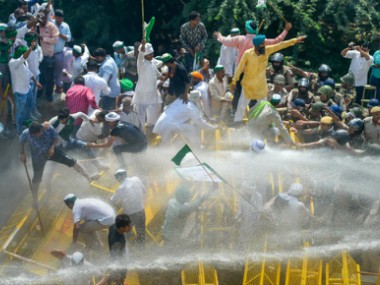The current farmers’ agitation demanding a higher minimum support price (MSP), among others, is puzzling for many since it had been raised by 15 percent for 13 kharif crops, on an average, in July this year – the highest since 2013. The
Union Cabinet is expected to raise MSP for rabi crops also when it meets in a few hours from now. So is the farmers’ agitation purely a political arm-twisting ahead of the 2019 elections or is there more to it? A part of the answer could be found in the income generated from farming. Ironical as it may seem, a 2017 Niti Aayog report says that farmers’ income has not kept pace with the growth in agriculture output – which has been low to begin with – resulting in low income for farmers. It quotes a NSSO survey for 2011-12 to show that 22.5 percent farm households had income less than the poverty line – ranging from 0.5 percent in Punjab to 45.3 percent in Jharkhand. Niti Aayog further says, farmers’ income has also remained considerably lower than that of non-agriculture workers. During the early 1980s, farm income per cultivator was just 34 percent of that of non-farm worker, which remained unchanged in the next decade but after 1993-94, it worsened and reached 25 percent of non-agriculture farmers. There was an improvement during 2004-5 to 2011-12 but no change over the 1983-84 level. The past four years (2012-13 to 2015-16) again witnessed deterioration in relative income of farmers. [caption id=“attachment_5309771” align=“alignleft” width=“380”] Thousands of farmers on Tuesday marched towards New Delhi. PTI[/caption] This low income and income disparity are a major cause of the agrarian distress, leading to farmers’ suicides and youngsters leaving farming. There isn’t adequate information on farmers’ income. However, some estimates are available. One 2015 study (Chand et al 2015) observed that income from farming is not adequate to keep 53 percent of farm households out of poverty, who operate on less than 0.63 hectare of land holdings. The average landholding in India is 0.59 hectare (including landless) and 0.64 hectare (excluding landless) – according to a NSSO report of 2015. A Situational Assessment Survey (SAS) of farm households released in 2016 says, the average monthly income of farm households during 2012-13 was Rs 6,426. It also says that only 60 percent of this income came from farm business – cultivation and farming animals. Thus farm income accounted for only Rs 3,855 per month. Now to give it a perspective, compare it with the minimum wages for industrial workers. In October 2012, the minimum wage for unskilled labour was Rs 6,960 (at Rs 232 per day for 30 working days), for semi-skilled Rs 7,870 (Rs 262.3 per day) and for skilled Rs 9,090 (Rs 303 per day). Farmers’ income, in comparison, was just about half that of an unskilled industrial worker. In terms of growth in farmers’ income, Niti Aayog estimates show in the first decade of economic liberalisation – 1993-94 to 2004-5 – the growth in real income per farmer was 1.96 percent. It went up to 7.46 percent from 2004-5 to 2011-12 and fell to 0.44 percent from 2011-12 to 2015-16. Taken together, farm incomes per farmer grew at 3.4 percent annually during 1993-94 to 2015-16. In fact, Niti Aayog says, it took 22 years from 1993-94 to 2015-16 for the real income of farmers to double! In terms of GDP growth, agriculture growth has been lagging behind the rest of the economy. Growth of both farm and non-farm sectors had remained the same until 1990-91. Thereafter, non-farm growth picked up from below 6 percent to above 8 percent for most of the period while farm growth has taken a cyclical path with a long term trend of 2.8 percent, according to Niti Aayog. Now to double farmers’ income by 2021-22 from the 2015-16 level – the avowed policy of the central government – Niti Aayog says two key things need to happen: (a) real income of farmers need to grow annually at 10.4 percent, which means the on-going and previously achieved growth in farm income has to be sharply accelerated and (b) various sources of growth – productivity of crops and livestock, efficiency of input use, high value crops, price realisation etc. – has to be accelerated by 33 percent. Niti Aayog concluded that “increase in real farm prices has a very high scope to raise farmers’ income”. Now, increasing MSP is a direct way of improving price realisation for farm produce and income of farmers. RBI database shows that the real MSP for paddy and wheat – two major items procured under MSP – has been declining since 2007-8. A 15 percent increase in MSP for the kharif crops in July 2018, therefore, was a welcome move. But the trouble with MSP is that only 6 percent of farmers directly gain from selling paddy and wheat to the government agencies. However, a higher MSP pushes up market price of the commodities, benefitting a far larger number of farmers. That is why farmers have been clamouring for higher MSP but face stiff resistance from governments and economists who seek to contain subsidies to improve fiscal health of the economy. That, however, is a hotly contested debate for another time.
The low income and income disparity are a major cause of the agrarian distress, leading to farmers’ suicides and youngsters leaving farming.
Advertisement
End of Article


)

)
)
)
)
)
)
)
)



